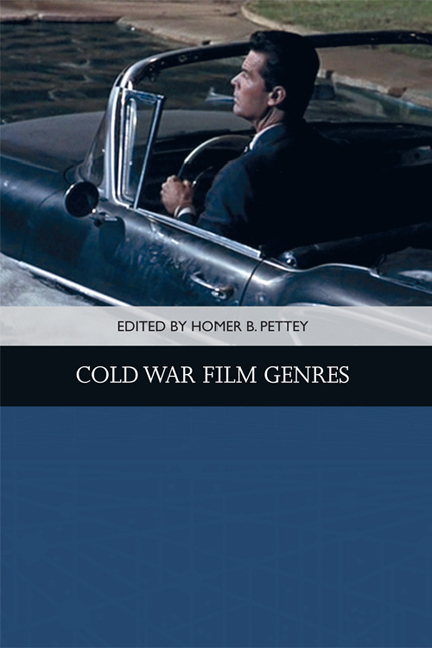Book contents
- Frontmatter
- Contents
- List of Illustrations
- Acknowledgments
- Notes on the Contributors
- 1 Introduction: Cold War Genres and the Rock-and-Roll Film
- 2 Social Factors in Brainwashing Films of the 1950s and 1960s
- 3 The Berlin Crisis? Piffl!: Billy Wilder’s Cold War Comedy, One, Two, Three
- 4 The Small Adult Film: A Prestige Form of Cold War Cinema
- 5 “I’m Lucky – I Had Rich Parents”: Disability and Class in the Postwar Biopic Genre
- 6 Rogue Nation, 1954: History, Class Consciousness, and the “Rogue Cop” Film
- 7 Internal Enmity: Hollywood’s Fragile Home Stories in the 1950s and 1960s
- 8 Suburban Sublime
- 9 Domestic Containment for Whom? Gendered and Racial Variations on Cold War Modernity in the Apartment Plot
- 10 Success and the Single Girl: Urban Romances of Working Women
- 11 Paris Loves Lovers and Americans Loved Paris: Gender, Class, and Modernity in the Postwar Hollywood Musical
- 12 Straight to Baby: Scoring Female Jazz Agency and New Masculinity in Henry Mancini’s Peter Gunn
- Index
5 - “I’m Lucky – I Had Rich Parents”: Disability and Class in the Postwar Biopic Genre
Published online by Cambridge University Press: 24 April 2021
- Frontmatter
- Contents
- List of Illustrations
- Acknowledgments
- Notes on the Contributors
- 1 Introduction: Cold War Genres and the Rock-and-Roll Film
- 2 Social Factors in Brainwashing Films of the 1950s and 1960s
- 3 The Berlin Crisis? Piffl!: Billy Wilder’s Cold War Comedy, One, Two, Three
- 4 The Small Adult Film: A Prestige Form of Cold War Cinema
- 5 “I’m Lucky – I Had Rich Parents”: Disability and Class in the Postwar Biopic Genre
- 6 Rogue Nation, 1954: History, Class Consciousness, and the “Rogue Cop” Film
- 7 Internal Enmity: Hollywood’s Fragile Home Stories in the 1950s and 1960s
- 8 Suburban Sublime
- 9 Domestic Containment for Whom? Gendered and Racial Variations on Cold War Modernity in the Apartment Plot
- 10 Success and the Single Girl: Urban Romances of Working Women
- 11 Paris Loves Lovers and Americans Loved Paris: Gender, Class, and Modernity in the Postwar Hollywood Musical
- 12 Straight to Baby: Scoring Female Jazz Agency and New Masculinity in Henry Mancini’s Peter Gunn
- Index
Summary
Facing an uncertain future in the years following World War II, the Hollywood studios embarked on several strategies that they hoped would lure audiences away from their new leisure activities and back into movie theaters. From his perch as resident film critic for the New York Times, Bosley Crowther identified one of the earliest tactics: the development of a genre that featured stories loosely based on the lives of then-famous celebrities. “The makers of Hollywood's films are nowadays doing something which they usually avoided in years gone by,” he declared in January 1946. “They are frankly making many movies about real-life personalities.” As Crowther further noted, the American film industry had begun moving away from a roman-à-clef approach to current biography (or a cinéma-à-clef approach, perhaps) in favor of a more straightforward one. “Hollywood has entered a phase wherein it strives to give [the] illusion of actuality to many of its stories of contemporary life,” he wrote, “and so it is making film biographies of living persons (or those but recently deceased) with personal identifications freely and proudly proclaimed.” Simply put, the classic Hollywood biographical film, or “biopic,” had been reborn.
Building on the decidedly mixed tradition of biographical films produced during the war years, the studios created a range of adulatory tributes to veterans and civilians alike who had recently been in the public eye or perhaps still were. Often laden with splashy production numbers, the biopics featured a general storyline that the studios thought would appeal to postwar audiences, particularly disabled veterans and their families: a larger-than-life personage struggling to “overcome” a disabling circumstance while at or nearing the height of his/her career. The figures and films in this strand included composer Cole Porter in Night and Day (1946), professional baseball player Monty Stratton in The Stratton Story (1949), pop singer Jane Froman in With a Song in My Heart (1952), opera diva Marjorie Lawrence in Interrupted Melody (1955), naval captain John Hoskins in The Eternal Sea (1955), naval lieutenant commander Frank “Spig” Wead in The Wings of Eagles (1957), and pre-presidential Franklin Roosevelt in Sunrise at Campobello (1960).
- Type
- Chapter
- Information
- Cold War Film Genres , pp. 79 - 98Publisher: Edinburgh University PressPrint publication year: 2018

